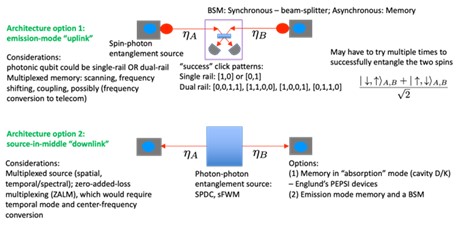State Transfer to a Quantum Memory Across a 43 km Boston-Area Network
Outcome/Accomplishment
Three key building blocks for repeaters, a crucial component of tomorrow's quantum internet, were successfully demonstrated by researchers at the Center for Quantum Networks (CQN), an NSF-funded Engineering Research Center (ERC) based at the University of Arizona.
Impact/Benefits
Because of the inherent fragility of qubits, or quantum information bits, developing repeaters is seen as critical to long-distance data transmission. The building blocks demonstrated at CQN help advance the development of the quantum networks that will revolutionize tomorrow's internet networks.
Explanation/Background
Qubits—whether existing as photons (particles of light), electrons, atoms, or other forms—are fragile because they are governed by quantum physics, or the physical attributes of very small objects. When at that tiny, nanoscale level, even slight contact with their environment can alter qubits and cause them to lose the information they are carrying.
The three breakthroughs demonstrated by CQN researchers include photon-mediated spin-spin entanglement using an efficient single-photon heralding scheme; electron-to-nuclear spin quantum logic, which can be an important enabler of fault-tolerant quantum repeaters; and quantum-state transfer over a 43-kilometer fiber network that runs between Harvard University and an MIT lab located outside Boston.
Location
Tucson, Arizonawebsite
Start Year
Microelectronics and IT
Microelectronics, Sensing, and IT
Lead Institution
Core Partners
Fact Sheet
Outcome/Accomplishment
Three key building blocks for repeaters, a crucial component of tomorrow's quantum internet, were successfully demonstrated by researchers at the Center for Quantum Networks (CQN), an NSF-funded Engineering Research Center (ERC) based at the University of Arizona.
Location
Tucson, Arizonawebsite
Start Year
Microelectronics and IT
Microelectronics, Sensing, and IT
Lead Institution
Core Partners
Fact Sheet
Impact/benefits
Because of the inherent fragility of qubits, or quantum information bits, developing repeaters is seen as critical to long-distance data transmission. The building blocks demonstrated at CQN help advance the development of the quantum networks that will revolutionize tomorrow's internet networks.
Explanation/Background
Qubits—whether existing as photons (particles of light), electrons, atoms, or other forms—are fragile because they are governed by quantum physics, or the physical attributes of very small objects. When at that tiny, nanoscale level, even slight contact with their environment can alter qubits and cause them to lose the information they are carrying.
The three breakthroughs demonstrated by CQN researchers include photon-mediated spin-spin entanglement using an efficient single-photon heralding scheme; electron-to-nuclear spin quantum logic, which can be an important enabler of fault-tolerant quantum repeaters; and quantum-state transfer over a 43-kilometer fiber network that runs between Harvard University and an MIT lab located outside Boston.

